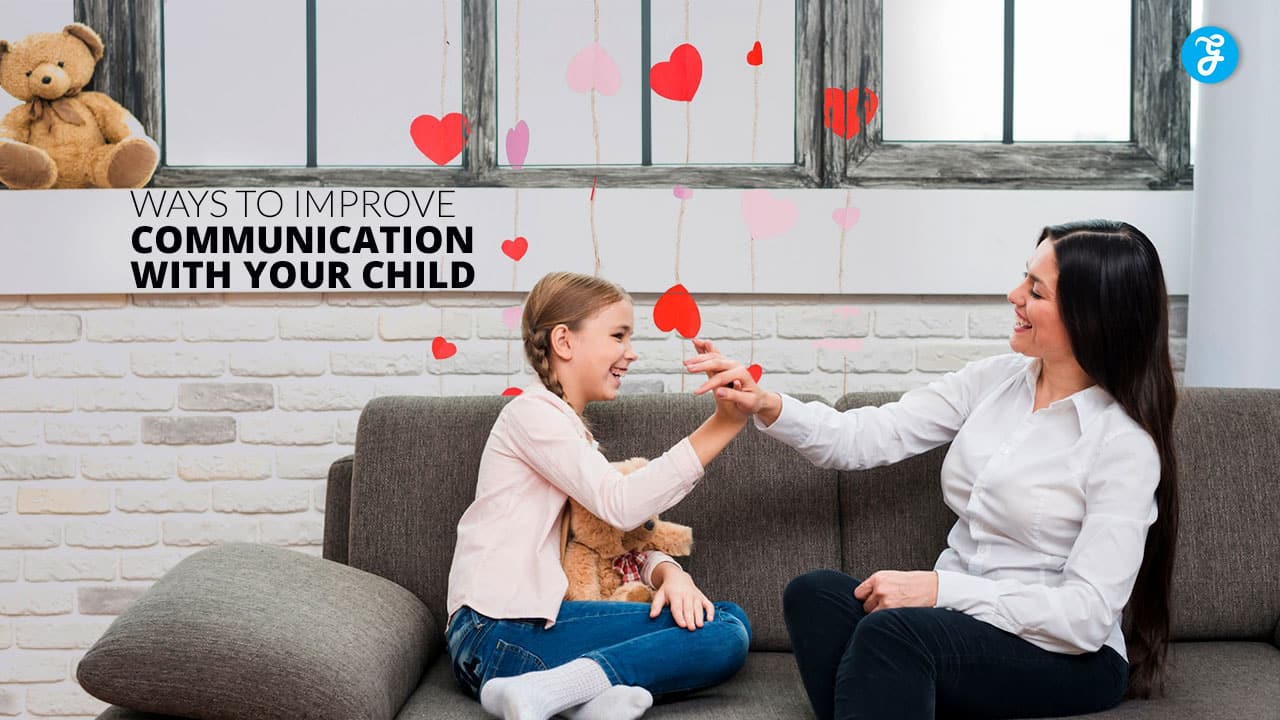Communication with your child is key to building a strong relationship. It helps you understand their thoughts, feelings, and needs. Good communication also boosts your child’s confidence and language skills.
Improving how you talk with your child can make a big difference in your bond. There are many ways to do this, from active listening to creating chances for open talks. By trying new approaches, you can connect better with your child and help them grow.
1. Active Listening
Active listening is a key skill for better communication with your child. It shows you care about what they say.
To listen actively, give your child your full attention. Put away your phone and turn off the TV. Make eye contact and nod to show you’re listening.
Try not to interrupt. Let your child finish their thoughts before you respond. This helps them feel heard and respected.
Repeat back what your child says in your own words. This confirms you understood them correctly. It also shows you were really listening.
Ask questions to learn more about what your child is telling you. This encourages them to share more details and feelings.
Pay attention to your child’s body language and tone of voice too. These can tell you a lot about how they’re feeling.
Practice active listening daily. It might feel awkward at first, but it gets easier with time. Your child will open up more as they see you truly listening.
Active listening builds trust between you and your child. It helps them feel valued and understood. This leads to better communication overall.
2. Maintain Eye Contact
Eye contact is key for good communication with your child. It shows you’re listening and care about what they’re saying.
Try getting down to your child’s level when talking. Squat or kneel so you’re face-to-face. This makes it easier for them to look at you.
Make eye contact fun with games. Try a staring contest or create a secret handshake that ends with looking into each other’s eyes.
Use positive reinforcement when your child makes eye contact. Smile and praise them to encourage this behavior.
If your child struggles with eye contact, start small. Ask them to look at your nose or forehead instead of directly into your eyes.
Push your child on a swing while standing in front of them. This naturally encourages eye contact and is enjoyable for kids.
Remember, some children find eye contact uncomfortable. Don’t force it if your child resists. Instead, work on it gradually over time.
Consistent practice can help improve your child’s eye contact skills. This can lead to better social and language development as they grow.
3. Encourage Open-Ended Questions
Open-ended questions help your child think and express themselves. They start with words like “what,” “how,” and “why.” These questions let kids share their thoughts and feelings freely.
Try asking your child, “What was the best part of your day?” This gives them a chance to talk about things that matter to them. It’s better than just asking, “Did you have a good day?”
You can also ask, “How did that make you feel?” This helps your child name their emotions. It shows you care about their feelings and want to understand them better.
When your child tells you about something, follow up with more open questions. If they mention a game they played, ask, “What did you like most about that game?” This keeps the conversation going.
Use open questions during daily activities too. At dinner, you might ask, “What was the funniest thing that happened today?” This can lead to fun family discussions.
Remember, there are no right or wrong answers to open-ended questions. The goal is to get your child talking and thinking. Listen closely to what they say and show interest in their ideas.
4. Use Positive Reinforcement
Positive reinforcement is a powerful tool to improve communication with your child. When you notice good behavior, reward it. This encourages your child to repeat those actions.
Praise is a simple form of positive reinforcement. Tell your child when they do something well. Be specific about what you liked. This helps them understand what behaviors to keep doing.
Small rewards can also work well. These might include stickers, extra playtime, or a special treat. Make sure the reward fits the behavior. Don’t overuse rewards, or they may lose their effect.
Positive notes are another great option. Leave a kind message in your child’s lunchbox or on their pillow. This shows you notice their efforts even when they’re not around.
Remember to reinforce good communication skills too. When your child expresses themselves clearly, let them know you appreciate it. This encourages them to keep talking to you openly.
5. Create a Safe Space
Making your child feel safe is key for good talks. A safe space lets them share freely without fear.
You can start by picking a comfy spot at home. This could be a cozy corner or a quiet room. Make sure it’s free from distractions.
Listen without judging when your child speaks. Show that you care about their thoughts and feelings. This helps them open up more.
Use kind words and a gentle tone. Avoid harsh reactions or criticism. This builds trust and makes your child feel valued.
Set aside regular time for chats. This could be daily check-ins or weekly talks. Consistency helps your child know when they can share.
Remember, a safe space isn’t just about the place. It’s about how you act and respond. Your actions create the feeling of safety for your child.
6. Practice Empathy
Empathy helps you connect with your child on a deeper level. It means trying to understand their feelings and experiences.
You can start by listening closely when your child talks. Pay attention to their words and body language. Try to see things from their point of view.
Ask questions to better understand how they feel. For example, “That sounds tough. How did it make you feel?” This shows you care about their emotions.
When your child is upset, avoid dismissing their feelings. Instead, validate them by saying something like, “I can see why you’d feel that way.”
Model empathy in your own actions. Show kindness to others and explain why you’re doing it. This teaches your child to consider others’ feelings.
Play games that encourage perspective-taking. Video games with prosocial themes can help develop empathy in a fun way.
Read stories together and discuss the characters’ emotions. Ask your child how they might feel in similar situations.
Teach your child to name their own emotions. This helps them recognize feelings in others too.
Practice empathy daily in small ways. Encourage your child to comfort a sad friend or help someone in need.
7. Set Clear Boundaries
Setting clear boundaries helps your child understand what’s okay and what’s not. It gives them a sense of security and structure.
Talk to your child about rules and expectations. Be specific about what behavior is acceptable and what isn’t. This helps avoid confusion and arguments later on.
Use simple, direct language when explaining boundaries. For example, “We don’t hit others” or “Bedtime is at 8 PM.” Make sure your child understands why these rules are important.
Be consistent with enforcing boundaries. If you let things slide sometimes, it can be confusing for your child. Stick to the rules you’ve set, even when it’s tough.
Remember that boundaries can change as your child grows. Be open to adjusting them when needed. Talk with your child about any changes and explain why they’re happening.
Praise your child when they follow the rules. This encourages good behavior and shows them you notice their efforts. It also helps build a positive relationship between you and your child.
8. Be Patient
Being patient is key when talking with your child. Kids often need extra time to process information and express themselves.
Take a deep breath when you feel frustrated. This helps you stay calm and respond better to your child’s needs.
Give your child time to speak without interrupting. Let them finish their thoughts, even if it takes a while.
Listen actively and show interest in what your child is saying. This encourages them to open up more.
Avoid rushing your child when they’re trying to communicate. Slow down and match their pace.
Remember that learning to communicate well takes time. Your child is still developing these skills.
Practice patience by setting aside dedicated time for conversations with your child. This shows them their thoughts matter to you.
When your child is upset, stay calm and patient. This helps them feel safe to express their emotions.
Be patient with yourself too. Improving communication is an ongoing process for both parents and children.
9. Lead by Example
Kids learn by watching you. Your actions speak louder than words. When you communicate well, your children will too.
Be respectful when you talk to others. Use a calm voice, even when upset. Say “please” and “thank you” often.
Listen carefully when others speak. Make eye contact and nod to show you’re paying attention. Don’t interrupt or talk over people.
Express your feelings in healthy ways. Use “I” statements like “I feel frustrated when…” instead of blaming or criticizing.
Apologize when you make mistakes. Admit when you’re wrong and ask for forgiveness. This teaches kids it’s okay to be imperfect.
Resolve conflicts peacefully. Find compromises and win-win solutions. Avoid yelling, name-calling, or physical aggression.
Practice active listening with your kids. Repeat back what they say to make sure you understand. Ask questions to learn more.
10. Use Stories and Examples
Stories and examples can make communication with your child more engaging and effective. You can use them to teach important lessons or explain complex ideas.
Try telling short stories about your own childhood experiences. This can help your child relate to you better. It also shows them that you understand what they’re going through.
Use examples from everyday life to illustrate your points. If you’re teaching about kindness, point out acts of kindness you see around you. This makes abstract concepts more concrete for children.
Books are great tools for communication too. Read stories together and talk about the characters’ actions and feelings. This can open up discussions about similar situations in your child’s life.
You can also create simple stories to address specific issues. For instance, if your child is struggling with sharing, make up a tale about animals learning to share their toys.
Remember to keep your stories and examples age-appropriate. Use language and scenarios that your child can easily understand. This will help ensure your message gets across clearly.
11. Admit Your Mistakes
Kids learn a lot from watching you. When you make a mistake, own up to it. This shows your child it’s okay to be wrong sometimes.
Say sorry when you mess up. Explain what happened and how you’ll fix it. This teaches your child how to handle their own mistakes.
Don’t try to hide your errors. Be open about them. This builds trust with your child. It also helps them feel safe talking to you about their own slip-ups.
Use mistakes as learning chances. Talk about what went wrong and how to do better next time. This helps your child see mistakes as opportunities to grow.
Remember, nobody’s perfect. Showing your child that you make mistakes too helps them feel less pressure to be perfect all the time.
12. Spend Quality Time Together
Spending quality time with your child is key to better communication. Turn off your phone and other devices when you’re together. This shows your child they have your full attention.
Try cooking a meal together. Let your child pick a recipe and help with the preparation. As you work side-by-side, you can chat about their day, friends, or interests.
Going for a walk is another great way to connect. Even a short 10-minute stroll gives you a chance to talk one-on-one without distractions.
Make time for fun and silliness too. Laugh together, play games, or have a dance party in the living room. These joyful moments create lasting bonds.
Remember, quality matters more than quantity. Even brief periods of focused attention can strengthen your relationship. Look for small opportunities throughout the day to give your child your undivided focus.
By prioritizing quality time, you create a safe space for open communication. Your child will feel more comfortable sharing their thoughts and feelings with you.
13. Avoid Interrupting
Interrupting can harm your talks with your child. It shows you’re not really listening. When you interrupt, your child may feel unimportant or ignored.
Let your child finish their thoughts before you speak. This helps them feel heard and valued. It also teaches them to do the same for others.
If you need to interrupt, do it politely. Say “Excuse me” or “I’m sorry to interrupt.” Then explain why you had to cut in. This sets a good example for your child.
Practice patience when your child is speaking. Even if they’re slow to get their point across, wait it out. This builds their confidence in sharing ideas.
If you catch yourself interrupting, stop and apologize. Say “I’m sorry, please continue.” This shows your child that everyone makes mistakes, but can fix them.
Remember, good communication goes both ways. By not interrupting, you create a space where your child feels safe to express themselves fully.
14. Offer Choices
Giving your child choices can boost communication and independence. When you offer options, you show respect for their opinions. This helps them feel heard and valued.
Try presenting two or three choices for simple decisions. You could ask, “Do you want apple slices or carrot sticks with lunch?” This lets your child practice making decisions in a safe way.
For older kids, you can offer more complex choices. “Would you like to clean your room before or after dinner?” This teaches them to manage their time and responsibilities.
Be sure to only offer choices you’re comfortable with. Don’t give an option you’re not willing to follow through on. This builds trust and shows your child that their input matters.
Using choices can also help reduce power struggles. When kids feel they have some control, they’re often more cooperative. This can make daily routines smoother for everyone.
Remember to use clear, simple language when presenting options. Give your child time to think and respond. This encourages thoughtful decision-making and improves communication skills.
15. Respect Their Opinions
Showing respect for your child’s opinions is key to good communication. When you value their thoughts, they feel heard and understood.
Let your child express their views freely. Don’t interrupt or dismiss what they say. Listen carefully and ask questions to learn more about their perspective.
Encourage your child to think critically. Ask them why they hold certain opinions. This helps them develop reasoning skills and confidence in their ideas.
You don’t have to agree with everything your child says. But you can still show respect by considering their viewpoint. Explain your own position calmly if you disagree.
Praise your child for sharing their thoughts. This builds their self-esteem and makes them more likely to open up in the future.
Remember that respecting opinions goes both ways. Model respectful disagreement when you talk about differing views with others.
By valuing your child’s opinions, you create a safe space for open dialogue. This strengthens your bond and helps your child become a confident communicator.
The Importance of Open Communication
Open communication builds strong relationships and helps children feel valued. It allows parents to understand their kids better and address issues effectively.
Building Trust and Respect
Open communication creates a foundation of trust between you and your child. When you listen without judgment, your child feels safe sharing thoughts and feelings. This trust leads to mutual respect.
Be available when your child wants to talk. Put away distractions like phones. Make eye contact and give your full attention. This shows you care about what they have to say.
Respond calmly, even if you disagree. Avoid criticism or lectures. Instead, ask questions to understand their point of view. This encourages them to keep coming to you with problems or concerns.
Understanding Your Child’s Perspective
Open communication helps you see things from your child’s point of view. This builds empathy and strengthens your bond.
Ask open-ended questions to learn more about their thoughts and feelings. For example, “What was the best part of your day?” or “How did that situation make you feel?”
Listen carefully to their answers without interrupting. Try to put yourself in their shoes. Remember that their experiences and emotions are valid, even if you see things differently.
Share your own experiences when appropriate. This shows your child that you can relate to their struggles. It also teaches them that it’s okay to be open about feelings.
Effective Listening Techniques
Good listening is key to better communication with your child. It helps you understand their thoughts and feelings, and shows them you care. Here are two powerful techniques to improve your listening skills.
Active Listening
Active listening means giving your child your full attention. Put away your phone and turn off the TV. Look at your child when they speak. Nod and smile to show you’re engaged. Don’t interrupt or try to finish their sentences.
Use short phrases like “I see” or “Uh-huh” to encourage them. Ask questions to learn more. “What happened next?” or “How did that make you feel?” can help your child open up.
Try to spot the feelings behind their words. If your child seems upset about a fight with a friend, you might say, “It sounds like you felt hurt when that happened.”
Reflective Listening
Reflective listening involves repeating back what your child says in your own words. This shows you heard them and helps check if you understood correctly.
For example, if your child says, “I hate math! It’s too hard!”, you might reply, “It sounds like you’re feeling frustrated because math is challenging for you right now.”
This technique gives your child a chance to clarify if needed. It also helps them feel heard and understood. Use it when your child shares important thoughts or feelings.
Remember to keep your tone neutral. Don’t judge or criticize what they say. Your goal is to understand, not to agree or disagree.
Using Positive Language
Positive language can transform how you talk to your child. It builds trust and encourages good behavior. Let’s explore two key aspects of using positive language with kids.
The Role of Encouragement
Encouragement helps kids feel valued and motivated. Use specific praise to highlight their efforts. Say “You worked hard on that puzzle!” instead of just “Good job.” This shows you notice their actions.
Focus on progress, not perfection. When your child tries something new, point out their bravery. You took a big step today by trying to tie your shoes.” This builds confidence.
Ask questions that spark thinking. “What part of the story did you like best?” This shows you’re interested in their thoughts.
Give sincere compliments daily. “I love how you helped your sister.” This reinforces kind behavior.
Avoiding Negative Phrases
Replace “don’t” with positive instructions. Instead of “Don’t run,” say “Please walk.” This tells kids what to do, not what not to do.
Use “when” instead of “if” to set expectations. “When you clean your room, we can go to the park.” This assumes they’ll do the task.
Swap “but” for “and” to avoid negating praise. “You did great on your test and there’s room to improve in math.” This keeps the focus positive.
Rephrase negative statements. Rather than “Stop whining,” try “Let’s use a calm voice.” This teaches better ways to communicate.
Takeaway
Improving communication with your child is one of the most rewarding investments you can make as a parent.
The 15 strategies outlined in this guide offer practical, effective ways to deepen your connection, foster trust, and create a positive environment where open dialogue thrives.
By actively listening, showing empathy, and respecting your child’s opinions, you build a foundation of trust and understanding that strengthens your relationship.
Implementing these techniques not only enhances your ability to communicate but also empowers your child to express themselves with confidence and clarity.













































